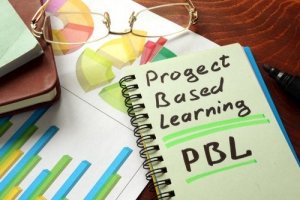Project-Based Learning: Students as Protagonists in Their Own Learning

The more traditional dynamic of a teacher-led classroom who passively feeds students information has no place in the Project-Based Learning (PBL) philosophy. The essence of PBL pedagogy is to assure that the student is the principal agent in his or her own learning.
With a PBL focus, every member of the education community is there to help students acquire the skills and the autonomy they need to carry out projects so they can learn how to solve everyday problems on their own.
What does Project-Based Learning entail?
Project-Based Learning is one of the pedagogies used in active approaches to learning. In contrast to the traditional methodologies of direct learning, PBL focuses on the knowledge the students develop themselves and this makes it easier to motivate them. Student learning is deeper and more rewarding as a result.
In addition, another aspect that sets PBL apart from the rest of the methodologies is how the roles of the teacher and student are very different. The teacher is a facilitator in an active learning scenario, and the student assumes a more active role in his or her own education.

Another key feature of PBL is its ecosystem approach to education. This means it’s necessary for everyone in the system to actively implement this kind of educational approach.
Likewise, educators have to analyze all the many factors that can affect development because these are interrelated with one another. The role of the teacher is to be a facilitator or a guide who orients the students as they embark on different projects.
How to develop a PBL project?
The development of a PBL project consists of three phases:
- First Phase. The student establishes the parameters for beginning the project, including the objectives, content, and tasks they’ll need to complete. The project topic should reflect the student’s interests. Therefore, the teacher will have to take this into consideration when helping the student pick a topic.
- Second Phase. The student begins to carry out the project and defines the final product. The final project can be a brochure or a science project, for example. Through teamwork, the students carry out research and reflect on their findings.
- Third and final phase. The students self-evaluate their performance and value the learning process almost as much as the end product. They develop the project in stages and evaluate what they’re in the process of learning before producing the final product. Thus, the students assimilate what they’ve learned more deeply.
What are the benefits of using this pedagogy?
Students look for information and produce their own content in PBL. They’re also taught to debate issues and reflect on the quality of the information they collect. This focus – which is on more than just the final product – improves students’ motivation to learn.
Willard and Dufferin, who are researchers at the University of Ohio, note that Project-Based Learning improves satisfaction and better prepares students to face real-life situations in the future.

“Present-day society has a new conception of teaching. Educators are continually updating their skills to keep with the times, and both the teacher and student are able to relate on the same level. They speak the same language.”
Eduardo Rodriguez Sandoval, professor at the National University in Colombia, maintains that students who participate in Project-Based Learning learn a great deal more and develop better skills.
They improve their ability to work as a team, and they show greater effort and interest. They learn to give presentations and they have a deeper understanding of academic and everyday concepts.
Finally, Project-Based Learning entails a re-conceptualization of the teaching and learning process. It’s a pedagogy that is better suited to the innovative demands of present-day society. It will help support a new generation of creative and forward-thinking students.
The more traditional dynamic of a teacher-led classroom who passively feeds students information has no place in the Project-Based Learning (PBL) philosophy. The essence of PBL pedagogy is to assure that the student is the principal agent in his or her own learning.
With a PBL focus, every member of the education community is there to help students acquire the skills and the autonomy they need to carry out projects so they can learn how to solve everyday problems on their own.
What does Project-Based Learning entail?
Project-Based Learning is one of the pedagogies used in active approaches to learning. In contrast to the traditional methodologies of direct learning, PBL focuses on the knowledge the students develop themselves and this makes it easier to motivate them. Student learning is deeper and more rewarding as a result.
In addition, another aspect that sets PBL apart from the rest of the methodologies is how the roles of the teacher and student are very different. The teacher is a facilitator in an active learning scenario, and the student assumes a more active role in his or her own education.

Another key feature of PBL is its ecosystem approach to education. This means it’s necessary for everyone in the system to actively implement this kind of educational approach.
Likewise, educators have to analyze all the many factors that can affect development because these are interrelated with one another. The role of the teacher is to be a facilitator or a guide who orients the students as they embark on different projects.
How to develop a PBL project?
The development of a PBL project consists of three phases:
- First Phase. The student establishes the parameters for beginning the project, including the objectives, content, and tasks they’ll need to complete. The project topic should reflect the student’s interests. Therefore, the teacher will have to take this into consideration when helping the student pick a topic.
- Second Phase. The student begins to carry out the project and defines the final product. The final project can be a brochure or a science project, for example. Through teamwork, the students carry out research and reflect on their findings.
- Third and final phase. The students self-evaluate their performance and value the learning process almost as much as the end product. They develop the project in stages and evaluate what they’re in the process of learning before producing the final product. Thus, the students assimilate what they’ve learned more deeply.
What are the benefits of using this pedagogy?
Students look for information and produce their own content in PBL. They’re also taught to debate issues and reflect on the quality of the information they collect. This focus – which is on more than just the final product – improves students’ motivation to learn.
Willard and Dufferin, who are researchers at the University of Ohio, note that Project-Based Learning improves satisfaction and better prepares students to face real-life situations in the future.

“Present-day society has a new conception of teaching. Educators are continually updating their skills to keep with the times, and both the teacher and student are able to relate on the same level. They speak the same language.”
Eduardo Rodriguez Sandoval, professor at the National University in Colombia, maintains that students who participate in Project-Based Learning learn a great deal more and develop better skills.
They improve their ability to work as a team, and they show greater effort and interest. They learn to give presentations and they have a deeper understanding of academic and everyday concepts.
Finally, Project-Based Learning entails a re-conceptualization of the teaching and learning process. It’s a pedagogy that is better suited to the innovative demands of present-day society. It will help support a new generation of creative and forward-thinking students.
All cited sources were thoroughly reviewed by our team to ensure their quality, reliability, currency, and validity. The bibliography of this article was considered reliable and of academic or scientific accuracy.
- Martí, J. A. (2010). Aprendizaje basado en proyectos. Revista Universidad, EADIT, 46 (158).
- Rodríguez de Sandoval, E. Vargas-Solano, È.M. y Luna-Cortés, J. (2010). Evaluación de la estrategia aprendizaje basado en proyectos. Educación y educadores. 13(1). 13-25- Recuperado de: https://www.redalyc.org/pdf/834/83416264002.pdf
- Sánchez, J. (2013). Qué dicen los estudios sobre el Aprendizaje Basado en Proyectos. Actualidad pedagógica. Recuperado de: http://www.estuaria.es/wp-content/uploads/2016/04/estudios_aprendizaje_basado_en_proyectos1.pdf
- Willard, K y Duffrin, M.W. (2003). Utilizing project-based learning and competition to develop student skills and interest in producing quality food items. Journal of Food Science Education. 2, 69, pp 69-73
This text is provided for informational purposes only and does not replace consultation with a professional. If in doubt, consult your specialist.








